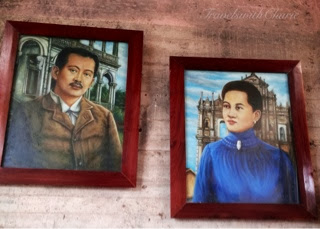The Ruins, Talisay City
In a residential neighborhood of Talisay is this evocative architectural demonstration of love - The Ruins. When Maria Braga died in an accident in 1911 while pregnant with her 11th child, her husband, Mariano Lacson, built this house in her memory. There's no mistaken whose house this belongs to. The double M (looks like E backwards) on the columns and pillars are the initials of Maria and Mariano.
Mariano Lacson and Maria Braga
The house which is reminiscent of European villas, is made of concrete which has the look and feel of marble as it was mixed with egg whites rather than water. The tiles were imported from Spain and have withstood years of exposure to the elements. The four tier water lily fountain is original to the property as is the sugar mill smokestack that is topped by a tree, a not so subtle reminder of a tower in Lucca, Italy.
Tiles from Spain
A house rule strictly followed by the family including Mariano himself was that only the unmarried members of the family could live in this house. Alas at the onset of World War II, the US Armed Forces in the Far East felt it necessary to torch structures that may be used by the Japanese for their headquarters. Maria's house burned for three days until only the framework remained as you see it now.
Staircase to the Belevedere
(notice the M initials on the side walls flanking the arched entry)
Mariano died in 1948. The ruins were left as it was for 67 years. Workers at the hacienda, vagabonds, and animals invited themselves to repose here. Mariano's grandson, Raymund Javellana, decided to restore the house in 2007. It was opened to the public in 2008, sixty years after Mariano's death.
A colonnaded balcony
The Ruins, what a tribute to enduring love!
* * *
The Ruins, Hacienda Santa Maria, Zone 15, Talisay City, Negros Occidental. Hours 8:30 am to 8 pm. daily. Entrance fee applies. Entertaining guide named Roger Laksoon.
How to get to Bacolod/Talisay City
Flights from Metro Manila to Bacolod on Philippine Airlines and Cebu Pacific. By supercat from Iloilo City, it costs P710.00 and takes approximately one hour and thirty minutes. Departures several times daily. Take taxi from airport or dock to Talisay.
Where to eat:
21 Restaurant
21 St., Corner Lacson
Bacolod
Phone: 34 433 4096
Try the lapulapu over eggplant. The pinakbet is very good.
Calea
14th St., Bacolod City
Desserts galore. Best known for their cheesecakes.
Where to shop for local delicacies
Virgie's Homemade Products
59 Sebastián St.
Bacolod
www.Virgieshomemade.com
Try their famous mango tarts.
Images by TravelswithCharie. All rights reserved.






Comments